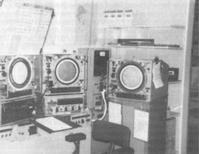


Radio Technical Officers
Foreword
Acknowledgements
Preface
Introduction
Chapter 1: The Early Years
Chapter 2: The Training School
Chapter 3: Equipment Installation Records
Chapter 4: The 'Techs' in Antarctica
Chapter 5: The 'Techs' Tell Their Stories
Trevor Donald Tells It All; Life in the Bureau from 1947 to 1989
Ray Clarke Looks Back
Some Memories from Ralph Bulloch
Peter Copland Works in Meteorological Electronics
Some Titbits from Dave Grainger
A Very Modest Tale from Alf Svensson
Adrian Porter Pulls No Punches
Jack Tait Recalls
Some Stories by Colourful Freddie Soutter
Some Snippets from Noel Barrett
Stephen CourbÍt Has His Penny Wworth
And a Flyspeck or Two from Lenny Dawson
Some Interesting Reminiscences from Jannes Keuken
Brief Stories from Phil Black
From Gloria West, Wife of the Late Bob West
The Life and Bureau Times of Graham Linnett
Tales Out of School from Bill Hite
Peter Copland on Cyclone Tracy
Peter Broughton Tells the Story of Maralinga
Appendix 1: 'Techs' Roll Call
Appendix 2: Trainee Intakes
Appendix 3: 'Techs' Who Have Served in the Antarctic Region
Appendix 4: Summary of Major Installation Projects
Appendix 5: Summary of Major Equipment Variously Installed at Sites and Maintained by Radio Technical Officers
Index
Search
Help
Contact us

The Life and Bureau Times of Graham Linnett (continued)
I underwent training as an Observer (Radio) in Melbourne in March 1963 with such notables as Arthur Carter, John Spehr, Noel Barrett and Peter Lane. We were all under the kindly guidance of Bureau 'giants' such as John Francis MacDermott, Arthur Shirley, Kev Lomas and Brian O'Connor. It was here that we were introduced to the latest in radars and other electronic equipment, the 277F radar and the AWA radiosonde equipment, both at that stage entering old age. All this latest technology and the best of test equipment, and it was readily available at each station in the form of an AVO meter and a Wee Megger. Reality started to rear its head. I'd given up working on the latest of high powered broadcast transmitters to work on this stuff.I don't know what it was that helped me through these troubled times. Was it the cold, miserably wet Melbourne weather? Was it the engulfment amongst all the other residents of the boarding house in front of the TV being continually bombarded with Aussie Rules? I actually attended a game with a couple of other Rugby League followers; had a couple of beers and a couple more and a couple more and a few more, still, I couldn't understand it.
There was only one 'bum' transfer to be handed out for our course. You've guessed who got it. After the course I was transferred to Eagle Farm, for a couple of weeks, just to pick up my gear and family, and was then thrust into the great outback at Forrest. This was a bit of rubbing salt into the wounds after spending three years in the desert at Cramsie via Longreach. The only differences were the presence of scrub at Cramsie and the larger population at Forrest. I suppose this must be considered as a step up in the world.

All things considered Forrest was a great place. There were some great people there; and some strange ones. A railway fettler's wife of Chilean extraction, having had enough of Australia's great outdoors, decided she was going home to Chile, on foot. She had her very young child with her and when the going got tough decided to travel alone. The child was left to look after himself under a rock. Luckily, both were found about 30 kilometres out. The transit of notables through Forrest was something to be wondered at. These included R. G. Menzies, Donald Campbell and actress Ann Baxter to name a few. An air hostess stood at the top of the aircraft stairs and exclaimed "Oh my goodness, what an awful place, what do you do for entertainment?". The response was "see Gordon over there; he's been here three years and has three children". The DCA 'tech' at Forrest for the early part of my stay was one John Gilbery. John was transferred back to Perth by DCA, where he 'saw the light' and joined the Bureau.
On completion of my tour at Forrest I was relieved by Jannes Keuken and posted to Brisbane as Observer (Radio) where I joined Merv German. Merv could be considered as the father of the two piece radar targets although there may be some in the Bureau who would dispute this. After a few months we were joined by one of the 'better class English technicians'. There were some great 'techs' among these fellows who were 'imported' to overcome a severe shortage of locals.
People in Bright Sparcs - Lomas, K. C. (Kev)
 |
Bureau of Meteorology |  |
© Online Edition Australian Science and Technology Heritage Centre and Bureau of Meteorology 2001
Published by Australian Science and Technology Heritage Centre, using the Web Academic Resource Publisher
http://www.austehc.unimelb.edu.au/fam/1262.html